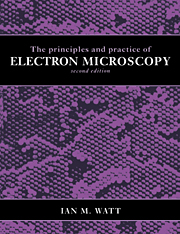Book contents
- Frontmatter
- Contents
- Preface to first edition
- Preface to second edition
- 1 Microscopy with light and electrons
- 2 Electron–specimen interactions: processes and detectors
- 3 The electron microscope family
- 4 Specimen preparation for electron microscopy
- 5 The interpretation and analysis of micrographs, pages 189 to 223
- The interpretation and analysis of micrographs, pages 224 to 262
- 6 Analysis in the electron microscope
- 7 Specialised EM- and other microscopical and analytical techniques
- 8 Examples of the use of electron microscopy
- Appendixes
- Bibliography
- Name index
- Subject index
4 - Specimen preparation for electron microscopy
Published online by Cambridge University Press: 05 June 2012
- Frontmatter
- Contents
- Preface to first edition
- Preface to second edition
- 1 Microscopy with light and electrons
- 2 Electron–specimen interactions: processes and detectors
- 3 The electron microscope family
- 4 Specimen preparation for electron microscopy
- 5 The interpretation and analysis of micrographs, pages 189 to 223
- The interpretation and analysis of micrographs, pages 224 to 262
- 6 Analysis in the electron microscope
- 7 Specialised EM- and other microscopical and analytical techniques
- 8 Examples of the use of electron microscopy
- Appendixes
- Bibliography
- Name index
- Subject index
Summary
Introduction
The reader has now been introduced to the theoretical background and the essential hardware of electron microscopy. The next step is to see what is involved in preparing actual specimens for examination by the various types of electron microscope. This chapter will give a general introduction to specimen preparation for electron microscopy, followed by an account of the preparation of more difficult subjects, such as moist or living (biological) materials.
The specimen requirements for scanning and transmission microscopy are very different, and preparation for the two techniques will therefore be dealt with separately. The reader is advised to follow both parts, however, as it is only by appreciating the distinctive features of each instrument that a balanced approach to electron microscopy can be obtained and maximum benefits obtained from it.
This book will only give the broad outline of basic procedures; for practical details of how to carry them out the reader should refer to laboratory manuals such as Kay (1965), Practical Methods in Electron Microscopy, edited by A. M. Glauert (the Glauert Series) or Procedures in Electron Microscopy, edited by A. W. Robards & A. J. Wilson. (See the bibliography, later).
Specimen requirements for the TEM
The essential conditions to be satisfied by a specimen for the transmission electron microscope are:
(i) It must transmit sufficient electrons to form an image, with minimum energy loss.
(ii) It must be stable under electron bombardment in a high vacuum.
(iii) It must be of a suitable size to fit the specimen holder of the microscope.
- Type
- Chapter
- Information
- The Principles and Practice of Electron Microscopy , pp. 136 - 188Publisher: Cambridge University PressPrint publication year: 1997
- 1
- Cited by

